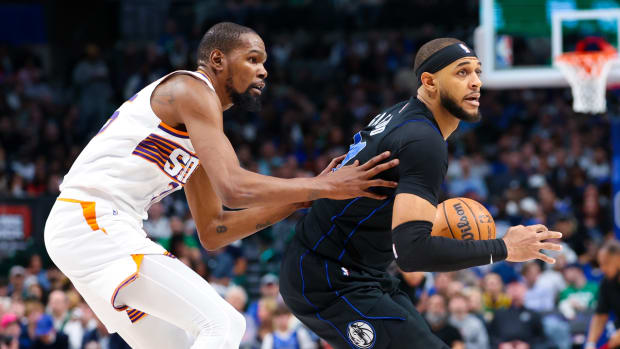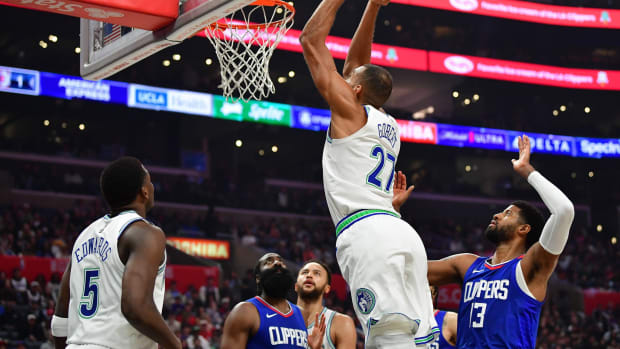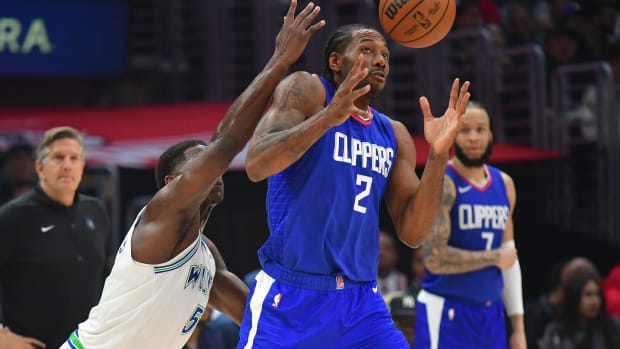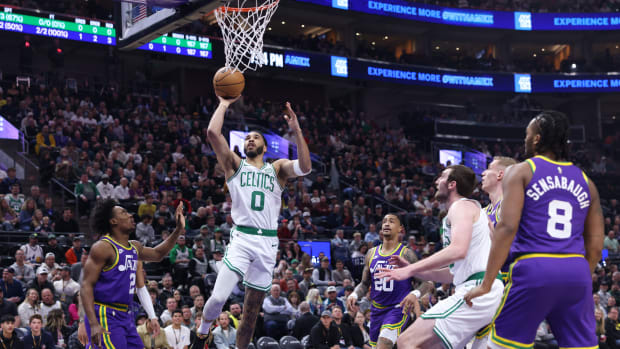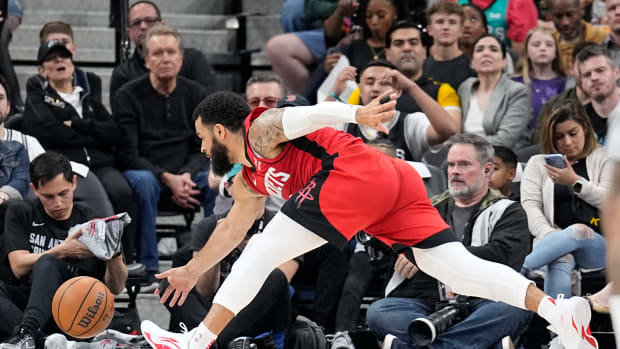Jayson Tatum’s Improved Passing Should Terrify the NBA
Jayson Tatum entered his fifth season as a two-time All-Star who’d already made one All-NBA team and two conference finals. Coming off a disappointing and chaotic 36–36 campaign that precipitated major changes in the Celtics’ infrastructure, expectations remained sky high for Tatum, who, at the age of 23, had already established himself as one of the sport’s most polished and dynamic scorers.
But for Boston to ultimately move in the right direction—especially after starting point guard Kemba Walker was traded to the Thunder—they’d need Tatum to buck lingering reservations about his ability to make the game easier for everyone around him, while still satiating his own need to get shots up. The circumstance begged a simple question: How good of a playmaker could he be?
It wouldn’t be reasonable to think the answer should be him one day surveying the floor like LeBron James, James Harden or Luka Dončić, hulkish point guards at heart who can lead/have led the league in assists. But to flourish as broadly as his talent demands, Tatum would have to improve his decision-making and display the same effective self-sacrifice that Kevin Durant, Giannis Antetokounmpo, Kawhi Leonard and other comparable archetypes have mastered, setting others up when positioned as a primary ball-handler against defenses that are programmed to slow them down. In August, incoming Celtics head coach Ime Udoka said Tatum’s growth here was critical. And for it to happen he’d need to ripen inside a brand new system, beside several different teammates, with no conventional point guard in the starting lineup.
Despite a 41-point, eight-assist performance against the Hornets in the fourth game of the season, the road towards becoming the well-rounded offensive force Boston needed him to be was bumpy early on, and it didn’t take long for criticism to surge.
After their infamous meltdown against the Bulls in early November, Marcus Smart said this about Tatum and Jaylen Brown, “They don’t want to pass the ball and that’s something that they’re going to learn … they are going to have to make another step and find ways to not only create for themselves but create for others on this team, to open up the court for them later in the game where they don’t always have to take those tough shots or take tough matchups when they do get the 1-on-1 and see a trap.”
A few weeks later, as Tatum struggled to find his shot and averaged only 3.4 assists per game through the season’s first 20, one anonymous assistant coach in the Eastern Conference called him self-centered: “Jayson Tatum is about Jayson Tatum. I don't think he cares about winning now, and if he does, it is on his terms. … He doesn't want to score 15 and win. He wants to score 39 and win.” Even 93-year-old Celtics legend Bob Cousy felt the need to chime in: “Right now, at crunch time in the fourth quarter, they’re giving it to Brown and Tatum to create for themselves and 70 percent of the time they do, but they don’t have the creating skills that a clever point guard would have, so they [expletive] it up.”
Fast forward to today, and it’s safe to say the 2021–22 season will be remembered as a transformative turning point in Tatum’s career, with a direct correlation between his own course correction and Boston’s shocking turnaround. Not only has he become an expert at making split-second decisions that place the team’s interests above his own—out of pick-and-rolls, in isolation and from the post—but his vision is now honed as an outright strength to the point where it’s okay to label him as one of the most intuitive playmakers at his position.
Tatum’s progress as a passer is real. It’s also hard to appreciate if statistical marks are your be all and end all way to measure this sort of thing. On the surface he is who he was last year. His assist rate and assists per 100 possessions are about what they were and he’s reached double-digits in assists only once (four days after that anonymous coach’s broadside was published by ESPN).
But he’s behaving in ways that weren’t evident earlier in his career; no other part of his game can better explain the leap he’s made from the periphery of All-NBA conversations to a serious MVP candidate. And in a new system that promotes ball movement, Tatum’s commitment to making the right play is more significant than his individual assist totals, though it should also be noted that he’s tallied at least six of them in five straight games, which is the longest streak of his career.
It led Udoka to say the following before a recent win against the Pacers: “JT is a guy that I'm not worried about stat-chasing or doing anything a specific way. He's playing the right way. And some things I've said about him is he should strive for 10 to 15 triple-doubles. That's an area he's grown in and scoring comes naturally, but all the other things that he's really improved on, there's no reason not to shoot and aim that high.”
Tatum was not a bad passer before, but this season has been a breakthrough; the alacrity at which he processes the floor is a major reason why. As the game slows down for Tatum, it speeds up for those who stand in his way. The ball pops out of his hands at the right time, fast enough to beat rotating defenders who’re often solely focused on preventing Tatum from scoring on his own. (This helps explain how Boston has by far the best offense in the NBA since the All-Star break.)
Some of his most constructive plays look elementary, but they weren’t happening as often before as they do now. Over the past few months they’ve become second nature. Here, against the Heat, Tatum knows Bam Adebayo will switch on him if he dribbles off Horford’s ball screen. In the past he’d accept this challenge and either drive, create space for a jumper or take an extra few beats to identify the help and formulate a plan to attack it. Instead, pretty much from the moment he gets the ball, Tatum’s eyes are on Jimmy Butler, who takes two steps towards the paint and away from Jaylen Brown as Adebayo comes up to defend the screen. Tatum subverts what he knows Miami wants to do and shovels the ball on to Marcus Smart before Horford’s pick is even set.
He doesn’t feel the need to force one-on-one confrontations. If a teammate’s defender is at the nail he’ll get off the ball, let them attack the gap and make a play. These plays personify selflessness and the type of patience and trust that’s vital for any star who knows passes like this will only open the floor for him as the game goes on.
In the past, Tatum could recognize a blitz and find the open man. But now he anticipates that pressure and generates an advantage for someone else instead of letting opponents force a pass that simply extends the possession as defenders rotate back in place. This left-handed pocket pass to Horford is a great example:
Down the stretch of last week’s loss against the Heat, when the Celtics started to hunt Tyler Herro, Tatum fought the urge to go one-on-one against a help-heavy defense that wouldn’t mind him doing just that. Instead he moved the ball and weaponized his teammates. Boston’s shooters had missed more than they had made and there was a case for Tatum to maybe be even more committed to his old instincts in those spots, but isolation scoring against the Heat (with Adebayo roaming around the paint) is much easier said than done.
On this play, with Adebayo getting brought into a switch, Tatum spots Herro’s over-help and immediately pushes the ball to Smart, who drives the gap and kicks to Brown for a corner three.
Earlier this season after a win against the Raptors when Tatum made a bevy of these passes Udoka praised his young star for leveraging his attention: “Be the guy that’s gonna bait guys out there. Be the decoy to some extent and draw that crowd and you see everybody else pretty much ate off of him tonight. So credit to him for playing the right way, not getting frustrated and then sticking with it.” Two seasons ago, Tatum tallied 24 hockey assists, which was as many as Shake Milton. Last year that number jumped to 47. Right now he’s at 67, tied with Chris Paul for 10th most in the league.
And then there’s passes that aren’t assists or secondary assists, but when you watch them occur within the flow of the game their impact is equally devastating. Take this one against the Kings. It's a dissection.
Tatum is now at the stage where he not only induces total panic when isolated in a mismatch, but is comfortable toying with scrambling defenders. The list of people who can even see the lane Tatum does before he whizzes this left-handed, off-the-bounce pass to the opposite corner is miniscule. The list of people who can actually execute it successfully can be counted on two hands.
His assuredness functioning with an accelerated tempo is useful when attacking a quick change in coverage, as seen here when the Wizards went (or tried to go) into a box-and-one. Tatum comes off a high screen and flings a dime to Grant Williams in the corner.
Tatum’s pass percentage out of the post is steadily rising, too. A couple years ago it was 22.4%, then 26.2% and now 32.8% this season. Once upon a time he’d dawdle through touches on the block as the shot clock wasted on. When help came he’d make the only pass he could, a beat after he needed to. Here’s an example from last year:
Now, run a set play to get him in the post and know he’s not only tall enough to see over a seven-footer who’s coming to double him, but deft enough to throw a no-look pass at the rim, knowing his own center is open.
Here he is walking into an isolation, knowing all along that the threat of his live dribble will force D’Angelo Russell to take a step up into the gap. Tatum has the ball for about one second before he cracks a bolt of lightning to Payton Pritchard in the corner. He knew the pass would be there long before he threw it.
A few months ago, plays like this weren’t on Tatum’s radar. He was chastised for being reluctant to even try them. Now, they help form the bedrock of a rapidly evolving skill-set that opposing coaches have no answer for.
There are several ways to become a better passer. A player can shave down their selfishness or toil through countless hours of film study and thousands upon thousands of simulated pick-and-rolls. After enough time, patterns form and the game’s rhythm is easier to manipulate. But just because you see the right play doesn’t mean you’ll always acknowledge it. Tatum now does both almost every time he touches the ball, and it’s a terrifying development for the rest of the NBA.
As Boston heads into the playoffs there are several reasons to believe they can win a championship. Previously a cause for skepticism, Tatum’s playmaking is now one of them.
More NBA coverage:
• Lakers Face Major Offseason Questions
• The Lakers Are In Ruins
• Analyzing the Top NBA Draft Prospects After March Madness






























